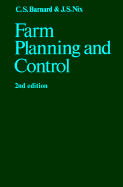Book contents
- Frontmatter
- Contents
- Notice to readers
- Preface to the first edition
- Preface to the second edition
- Selected metric conversion factors
- Part I The organisation of resources
- Part II The organisation of enterprises
- 6 An introduction to enterprise organisation
- 7 Livestock yield and fixed costs
- 8 Yield, variable costs and optimal feed conversion
- 9 The selection of feedstuffs
- 10 The influence of season on livestock production
- 11 The provision of replacements
- 12 Crops and cropping
- Part III The combination of enterprises
- Part IV The control of resources and enterprises
- Selected further reading
- Index
6 - An introduction to enterprise organisation
Published online by Cambridge University Press: 01 June 2011
- Frontmatter
- Contents
- Notice to readers
- Preface to the first edition
- Preface to the second edition
- Selected metric conversion factors
- Part I The organisation of resources
- Part II The organisation of enterprises
- 6 An introduction to enterprise organisation
- 7 Livestock yield and fixed costs
- 8 Yield, variable costs and optimal feed conversion
- 9 The selection of feedstuffs
- 10 The influence of season on livestock production
- 11 The provision of replacements
- 12 Crops and cropping
- Part III The combination of enterprises
- Part IV The control of resources and enterprises
- Selected further reading
- Index
Summary
It was seen in Chapter 1 that the planning of the use of farm resources breaks down into the twin problems of discovering the best way of organising individual enterprises and the best way of fitting them together into an overall farming system. The first requires the farmer to look inwards at his enterprises in order to decide the methods and techniques to adopt in running them. The second requires him to look outward from them, to see how they compete against or complement one another in their use of scarce resources. Although this part of the book concentrates on enterprise organisation, it does not imply that the two sides of planning can be divorced from one another, for both are closely linked aspects of the same general problem and must, in practice, be considered together.
Enterprise organisation and fixed resources
Before proceeding further, it is pertinent to consider what is meant by an 'enterprise'. In the commonly accepted sense, enterprises are distinguished from one another by virtue of their different end-products: for example, barley as opposed to sugar beet, or table poultry as opposed to eggs. This may not, however, always suffice in the context of economic planning, where the distinction between enterprises rests on their giving different returns to fixed resources. The first part of Table 6.1 demonstrates that in this sense barley and sugar beet are, indeed, distinct enterprises, as they give different returns to land and autumn labour.
- Type
- Chapter
- Information
- Farm Planning and Control , pp. 157 - 164Publisher: Cambridge University PressPrint publication year: 1980



